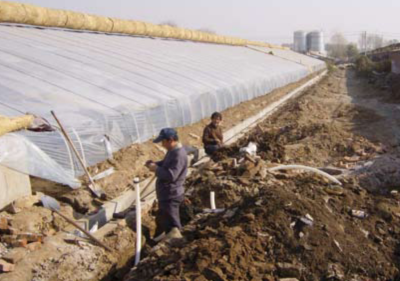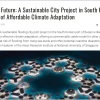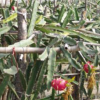Summary
Beijing is facing a shortage of water. Because of a downward trend in rainfall, surface water is gradually drying up and the level of groundwater is declining. This decline in availability of water is affecting urban agriculture in the city. Innovations are being sought by both the government and farmers focusing on the use of new water sources, like reuse of wastewater and rainwater harvesting, and improved water management.
Introduction
Although groundwater is still the main water source for urban agriculture in Beijing (90 percent in 2003), in some areas groundwater is not accessible anymore. In April 2007 the Beijing municipal government started to charge a fee for agricultural use exceeding a certain quota. Thus farmers are confronted with a rising cost of agricultural production. On the other hand, water use efficiency in agriculture is still comparatively very low. The SWITCH programme supports the demonstration of multiple uses of rainwater, including an agro-tourism component, and by conducting research into water flows, water quality and the cost-benefit ratio of collecting rainwater. This article puts the SWITCH activity in Beijing into a broader context.
Wastewater use
The use of wastewater has a long history in China. But not until 2000 did farmers around Beijing start to use treated water from the central wastewater treatment plants, which was initiated by the municipal government in an attempt to reduce depletion of groundwater. In 2004, only 70 million m3 of treated water was used for urban agriculture in Beijing. This amount increased to 230 million m3 in 2007 and accounted for about 20 percent of total water used for irrigation. The 11th five-year plan states that 400 million m3 treated water will be available for more than 0.66 million ha of croplands in Beijing in 2010, which is less than one quarter of agricultural land in Beijing municipality. Almost all kinds of crops and fruit trees are suitable for the use of treated wastewater. However, not all the farmers can access treated wastewater because they are located too far from the wastewater treatment plants.
Rainwater harvesting
In addition to the use of (treated) wastewater, the use of rainwater is an important (potential) source for the water needs of parks, gardens and agriculture in Beijing municipality. Rainwater harvesting systems are currently being promoted in residential areas in Beijing and in periurban agriculture. Capturing rainwater in residential areas of the city has been promoted since 2000. This includes techniques like porous pavement and roadside gutter collection of stormwater (rainwater from the roof and road) and storage in local deposit pools, after which this water is transferred to larger water-saving ponds for primary treatment (sedimentation).
This water can be used for many purposes, such as irrigation of parks and gardens, aquifer recharge, maintaining water levels at small ponds and lakes in the city, and other uses like car washing (after some simple treatments). The number of projects introducing these uses has been increasing in Beijing, especially in the last two years. For example, in the Beijing National Stadium for the Olympics captured rainwater was used for toilet cleaning, cooling towers, fire fighting, and irrigation of green areas. In 2006 more than 300 rainwater-collecting projects were implemented, and the capacity for collecting water In Beijing has consequently increased to 40 million cubic metres. Rainwater harvesting using roofs of houses in rural China has been practiced for thousands of years. Using the roofs of greenhouses to capture rainwater for irrigation of crops has been promoted since June 2005.
These projects became popular because they are relatively simple to use and maintain, and because they are subsidised by the government. So far, twenty of these rainwater harvesting systems have been installed. On average, 200-300 m3 of rainwater can be collected per greenhouse (with a roof of 667 m2) each year, which can irrigate 2-3 times the same area with efficient irrigation (drip irrigation). The demonstration project of SWITCH in Beijing supports this work by analysing water flows, adding the use of wastewater, by conducting cost/benefit analyses of typical farming systems, and by linking other productive activities, like mushroom production and agro-tourism.
So the potential of this technique is high, and given that there were some 20,000 ha of agriculture land under glasshouses in 2005 in Beijing, the current proportion of irrigation using rainwater harvesting is very low, accounting for less than 1 percent.
Improving water management
The Beijing Municipal Water Authority was founded in 2004, illustrating the beginning of reforms in the water management system of urban and periurban Beijing. Integrated urban-rural water management is being developed at four levels: municipality, districts and counties, water stations and at user (farmer) level. At the latter level, the Beijing Water Authority has village water managers and stimulates the organisation of farmers’ water use associations or cooperatives. These village level associations manage issues such as access to water (and developing alternatives, like using wastewater and building rainwater harvesting structures), water pricing, irrigation practices, and quota management.
By the end of 2006, Beijing had established more than 3,339 of these farmers’ water use associations. Every villager (except the village leaders in order to prevent power from becoming too concentrated in the hands of few people) has the right to apply for the position of water manager, and selected villagers will receive capacity building training from the Water Authority. In December 2006, 10,800 farmers were appointed as water managers of their villages in Beijing (the total number of periurban villages in Beijing is 3,954). Future perspective Integrated reuse of wastewater, rainwater harvesting, and more efficient water use (e.g. by village water managers and farmers’ water use cooperatives) are important technological and institutional innovations in Beijing. Challenges remain, especially in terms of financial sustainability. Farmers in Beijing municipality are used to having free access to all kinds of water for agricultural purposes. If a fee is charged, higher returns will also need to be established. But this also opens new opportunities to improve current farming systems.
The SWITCH programme in Beijing, together with the RUAF-CFF programme, seeks to demonstrate a model of urban agriculture which incorporates multiple sources and efficient use of water and delivers higher returns by diversifying production and services. These higher returns not only compensate for water fees, but also enable farmers to pay for the relatively high investment in rainwater harvesting facilities.
Ji Wenhua and Cai Jianming IGSNRR. Urban Agriculture Magazine no. 20 – Water for Urban Agriculture












Trending Discussions
From around the site...
“Absolutely interested! I'll connect via email to discuss reviewing and enhancing the Economic Analysis of Climate...”
Adaptation-related events at COP28 (all available to follow/stream online)
“Please check out these adaptation-related events taking place at COP28 - all available online (some in person too if...”
Shining a light for biodiversity – four perspectives to the life that sustains us. Four hybrid sessions.
“30 November to 19 December 2023 - Four Sessions Introduction The SDC Cluster Green is happy to invite you to the...”